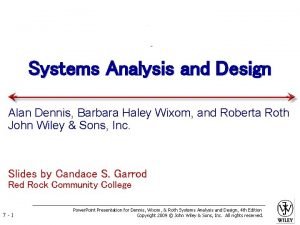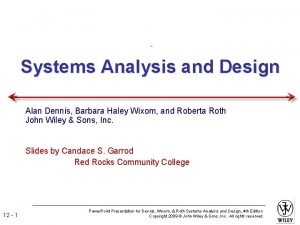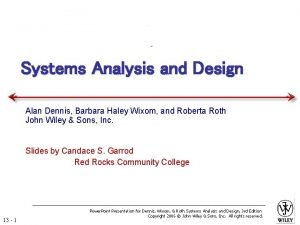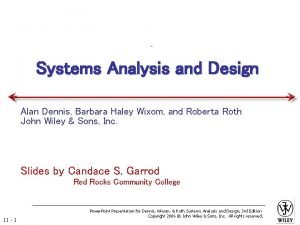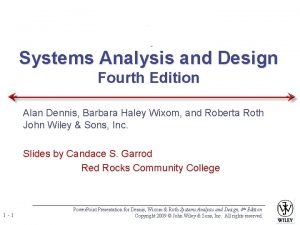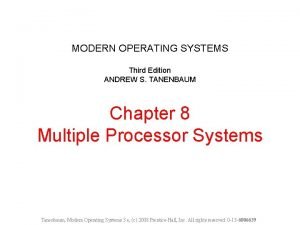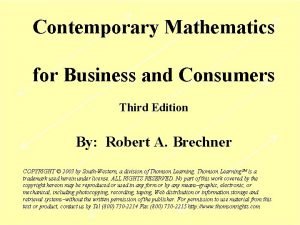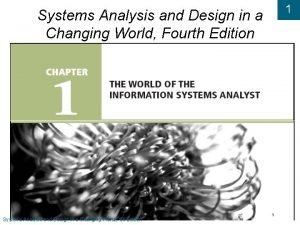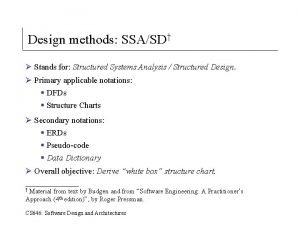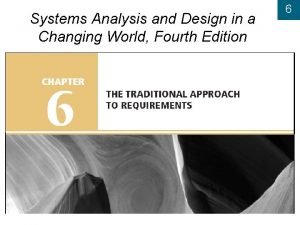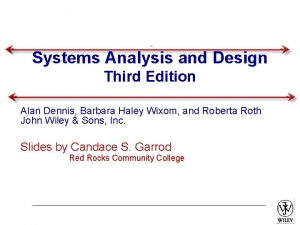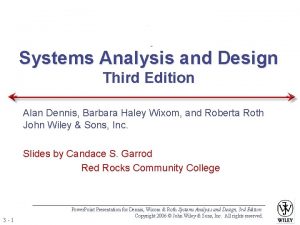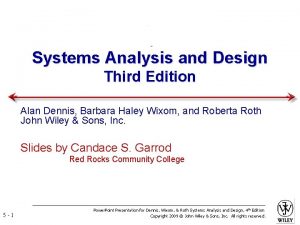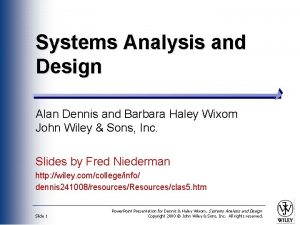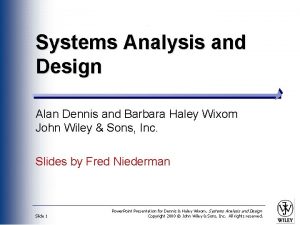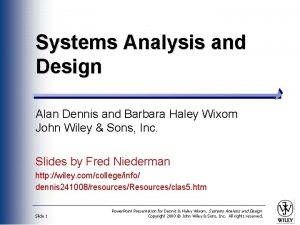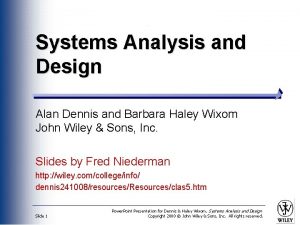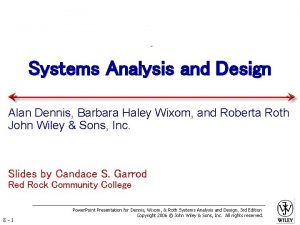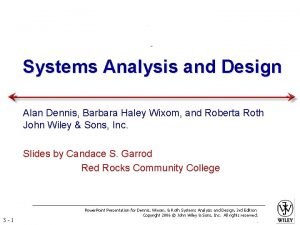Systems Analysis and Design Third Edition Alan Dennis





















































- Slides: 53

Systems Analysis and Design Third Edition Alan Dennis, Barbara Haley Wixom, and Roberta Roth John Wiley & Sons, Inc. Slides by Candace S. Garrod Red Rocks Community College 5 -1 Power. Point Presentation for Dennis, Wixom, & Roth Systems Analysis and Design, 3 rd Edition Copyright 2006 © John Wiley & Sons, Inc. All rights reserved.

Use Case Analysis 5 -2 Power. Point Presentation for Dennis, Wixom, & Roth Systems Analysis and Design, 3 rd Edition Copyright 2006 © John Wiley & Sons, Inc. All rights reserved.

Key Ideas Use cases are a text-based method of describing and documenting complex processes Use cases add detail to the requirements outlined in the requirement definition Systems analysts work with users to develop use cases Systems analysts develop process and data models later based on the use cases 3 Power. Point Presentation for Dennis, Wixom, & Roth Systems Analysis and Design, 3 rd Edition Copyright 2006 © John Wiley & Sons, Inc. All rights reserved.

Use Cases 5 -4 Power. Point Presentation for Dennis, Wixom, & Roth Systems Analysis and Design, 3 rd Edition Copyright 2006 © John Wiley & Sons, Inc. All rights reserved.

Roles of Use Cases A use case is a set of activities that produce some output result Describes how the system reacts to an event that triggers the system Trigger -- event that causes the use case to be executed Event-driven modeling – everything in the system is a response to some triggering event 5 Power. Point Presentation for Dennis, Wixom, & Roth Systems Analysis and Design, 3 rd Edition Copyright 2006 © John Wiley & Sons, Inc. All rights reserved.

Role of Use Cases All possible responses to the event are documented Use cases are helpful when the situation is complicated 6 Power. Point Presentation for Dennis, Wixom, & Roth Systems Analysis and Design, 3 rd Edition Copyright 2006 © John Wiley & Sons, Inc. All rights reserved.

Elements of a Use Case Basic information Name, number and brief description Trigger – event that causes the use case to being External trigger – some from outside the system Temporal triggers – time-based occurrences Viewpoint of the use cases should be consistent Major inputs and outputs Sources and destinations Goal is to be all inclusive Details Steps performed and the data inputs and outputs 7 Power. Point Presentation for Dennis, Wixom, & Roth Systems Analysis and Design, 3 rd Edition Copyright 2006 © John Wiley & Sons, Inc. All rights reserved.

Sample Use Case

Building Use Cases 5 -9 Power. Point Presentation for Dennis, Wixom, & Roth Systems Analysis and Design, 3 rd Edition Copyright 2006 © John Wiley & Sons, Inc. All rights reserved.

Process of Developing Use Cases Identify the major use cases Identify the major steps within each use case Identify elements within steps Confirm the use case Cycle through the above steps iteratively 10 Power. Point Presentation for Dennis, Wixom, & Roth Systems Analysis and Design, 3 rd Edition Copyright 2006 © John Wiley & Sons, Inc. All rights reserved.

Step 1: Identify the major use cases Activities Start a use case form for each use case If more than nine, group into packages 11 Typical Questions Asked Ask who, what, and where about the tasks and their inputs and outputs: What are the major tasks performed? What triggers this task? What tells you to perform this task? What information/forms/reports do you need to perform this task? Who gives you these information/forms/reports? What information/forms/reports does this produce and where do they go? Power. Point Presentation for Dennis, Wixom, & Roth Systems Analysis and Design, 3 rd Edition Copyright 2006 © John Wiley & Sons, Inc. All rights reserved.

Sample List of Events-Actions Based on Requirements Definition 12 Power. Point Presentation for Dennis, Wixom, & Roth Systems Analysis and Design, 3 rd Edition Copyright 2006 © John Wiley & Sons, Inc. All rights reserved.

Step 2: Identify the major steps within each use case Activities Typical Questions Asked For each use case, fill in the major steps needed to process the inputs and produce the outputs Ask how about each use case: How do you produce this report? How do you change the information on the report? How do you process forms? What tools do you use to do this step (e. g. , on paper, by email, by phone)? 13 Power. Point Presentation for Dennis, Wixom, & Roth Systems Analysis and Design, 3 rd Edition Copyright 2006 © John Wiley & Sons, Inc. All rights reserved.

Step 3: Identify elements within steps Activities For each step, identify its triggers and its inputs and outputs 14 Typical Questions Asked Ask how about each step How does the person know when to perform this step? What forms/reports/data does this step produce? What forms/reports/data does this step need? What happens when this form/report/data is not available? Power. Point Presentation for Dennis, Wixom, & Roth Systems Analysis and Design, 3 rd Edition Copyright 2006 © John Wiley & Sons, Inc. All rights reserved.

Step 4: Confirm the use case Activities Typical Questions Asked • For each use case, • Ask the user to execute the process using the validate that it is correct written steps in the use case – that is, have the and complete user role-play the use case 15 Power. Point Presentation for Dennis, Wixom, & Roth Systems Analysis and Design, 3 rd Edition Copyright 2006 © John Wiley & Sons, Inc. All rights reserved.

CD SELECTIONS 16 Power. Point Presentation for Dennis, Wixom, & Roth Systems Analysis and Design, 3 rd Edition Copyright 2006 © John Wiley & Sons, Inc. All rights reserved.

CD SELECTIONS 17 Power. Point Presentation for Dennis, Wixom, & Roth Systems Analysis and Design, 3 rd Edition Copyright 2006 © John Wiley & Sons, Inc. All rights reserved.

CD SELECTIONS 18 Power. Point Presentation for Dennis, Wixom, & Roth Systems Analysis and Design, 3 rd Edition Copyright 2006 © John Wiley & Sons, Inc. All rights reserved.

CD SELECTIONS 19 Power. Point Presentation for Dennis, Wixom, & Roth Systems Analysis and Design, 3 rd Edition Copyright 2006 © John Wiley & Sons, Inc. All rights reserved.

Summary Use cases contain all the information needed for process modeling, but are easier for users to comprehend Use cases are created in an iterative cycle of steps until they are considered accurate and complete 20 Power. Point Presentation for Dennis, Wixom, & Roth Systems Analysis and Design, 3 rd Edition Copyright 2006 © John Wiley & Sons, Inc. All rights reserved.

Systems Analysis and Design with UML Version 2. 0, Second Edition Alan Dennis, Barbara Wixom, and David Tegarden Chapter 6: Functional Modeling John Wiley & Sons, Inc. Copyright 2005 Slide 21 Power. Point Presentation for Dennis, Wixom & Tegardem Systems Analysis and Design Copyright 2001 © John Wiley & Sons, Inc. All rights reserved.

Objectives ■ Understand the rules and style guidelines for activity diagrams. ■ Understand the rules and style guidelines for use cases and use case diagrams. ■ Understand the process used to create use cases and use case diagrams. ■ Be able to create functional models using activity diagrams, use cases, and use case diagrams. ■ Become familiar with the use of use case points. 22 Power. Point Presentation for Dennis, Wixom & Tegardem Systems Analysis and Design Copyright 2001 © John Wiley & Sons, Inc. All rights reserved.

Business Process Modeling with Activity Diagrams Elements of an Activity Diagram ±Guidelines for Creating Activity Diagrams ± Slide 23 Power. Point Presentation for Dennis, Wixom & Tegardem Systems Analysis and Design Copyright 2001 © John Wiley & Sons, Inc. All rights reserved.

BPM With Activity Diagrams A number of activities support a business process across several departments Activity diagrams model the behavior in a business process Sophisticated data flow diagrams Addresses Parallel concurrent activities and complex processes 24 Power. Point Presentation for Dennis, Wixom & Tegardem Systems Analysis and Design Copyright 2001 © John Wiley & Sons, Inc. All rights reserved.

Activity Diagram Example 25 Power. Point Presentation for Dennis, Wixom & Tegardem Systems Analysis and Design Copyright 2001 © John Wiley & Sons, Inc. All rights reserved.

Creating Activity Diagrams 1. Since an activity diagram can be used to model any kind of process, you should set the context or scope of the activity being modeled. Once you have determined the scope, you should give the diagram an appropriate title. 2. You must identify the activities, control flows, and object flows that occur between the activities. 3. You should identify any decisions that are part of the process being modeled. 4. You should attempt to identify any prospects for parallelism in the process. 5. You should draw the activity diagram. 26 Power. Point Presentation for Dennis, Wixom & Tegardem Systems Analysis and Design Copyright 2001 © John Wiley & Sons, Inc. All rights reserved.

USE-CASE DESCRIPTIONS Slide 27 Power. Point Presentation for Dennis, Wixom & Tegardem Systems Analysis and Design Copyright 2001 © John Wiley & Sons, Inc. All rights reserved.

Key Ideas A use case illustrates the activities that are performed by users of a system. Use cases are logical models -- they describe the activities of a system without specifying how the activities are implemented. 28 Power. Point Presentation for Dennis, Wixom & Tegardem Systems Analysis and Design Copyright 2001 © John Wiley & Sons, Inc. All rights reserved.

What are Use-Case Descriptions? Describe basic functions of the system What the user can do How the system responds Use cases are building blocks for continued design activities. 29 Power. Point Presentation for Dennis, Wixom & Tegardem Systems Analysis and Design Copyright 2001 © John Wiley & Sons, Inc. All rights reserved.

How Are Use-Cases Created? Two steps: Write text-based case descriptions Translate descriptions into diagrams Describes one and only one function, but may have multiple paths. Developed working with users for content. 30 Power. Point Presentation for Dennis, Wixom & Tegardem Systems Analysis and Design Copyright 2001 © John Wiley & Sons, Inc. All rights reserved.

Types of Use-Cases Overview versus detail ■ The use case represents an important business process. ■ The use case supports revenue generation or cost reduction. ■ Technology needed to support the use case is new or risky and therefore will require considerable research. Essential versus real 31 Power. Point Presentation for Dennis, Wixom & Tegardem Systems Analysis and Design Copyright 2001 © John Wiley & Sons, Inc. All rights reserved.

Elements of a Use-Case Description Use Case Name: ID: Primary Actor: Use Case Type: Importance Level: Stakeholders and Interests: Brief Description: Trigger: Relationships: (Association, Include, Extend, Generalization) Normal Flow of Events: Subflows: Alternate/Exceptional Flows: 32 Power. Point Presentation for Dennis, Wixom & Tegardem Systems Analysis and Design Copyright 2001 © John Wiley & Sons, Inc. All rights reserved.

Guidelines for Creating Use-Case Descriptions Write each step in “SVDPI” form Clarify initiator and receivers of action Write from independent observer perspective Write at same level of abstraction Ensure a sensible set of steps Apply KISS principle liberally Write repeating instructions after the set of steps to be repeated. 33 Power. Point Presentation for Dennis, Wixom & Tegardem Systems Analysis and Design Copyright 2001 © John Wiley & Sons, Inc. All rights reserved.

Your Turn How would you make requirements gathering (interviews, questionnaires, observation, and document analysis) more effective by knowing that eventually you will be creating use-case descriptions and diagrams? 34 Power. Point Presentation for Dennis, Wixom & Tegardem Systems Analysis and Design Copyright 2001 © John Wiley & Sons, Inc. All rights reserved.

USE-CASE DIAGRAMS Slide 35 Power. Point Presentation for Dennis, Wixom & Tegardem Systems Analysis and Design Copyright 2001 © John Wiley & Sons, Inc. All rights reserved.

Syntax for Use-Case Diagram 36 Power. Point Presentation for Dennis, Wixom & Tegardem Systems Analysis and Design Copyright 2001 © John Wiley & Sons, Inc. All rights reserved.

The Use-Case Diagram for Appointment System 37 Power. Point Presentation for Dennis, Wixom & Tegardem Systems Analysis and Design Copyright 2001 © John Wiley & Sons, Inc. All rights reserved.

Use-Case Diagram with Specialized Actor 38 Power. Point Presentation for Dennis, Wixom & Tegardem Systems Analysis and Design Copyright 2001 © John Wiley & Sons, Inc. All rights reserved.

Extend and Include Relationships 39 Power. Point Presentation for Dennis, Wixom & Tegardem Systems Analysis and Design Copyright 2001 © John Wiley & Sons, Inc. All rights reserved.

CREATING USE-CASE DESCRIPTIONS AND USECASE DIAGRAMS Slide 40 Power. Point Presentation for Dennis, Wixom & Tegardem Systems Analysis and Design Copyright 2001 © John Wiley & Sons, Inc. All rights reserved.

Major Steps in Writing Use. Cases Case Diagrams Identify the major use-cases Expand the major use-case Confirm the major use-cases Create the use-case diagram 41 Power. Point Presentation for Dennis, Wixom & Tegardem Systems Analysis and Design Copyright 2001 © John Wiley & Sons, Inc. All rights reserved.

Identifying the Major Use. Cases Identify the system’s boundaries List the primary actors List the goals of each primary actor Identify and write the major usecases Carefully review use-cases 42 Power. Point Presentation for Dennis, Wixom & Tegardem Systems Analysis and Design Copyright 2001 © John Wiley & Sons, Inc. All rights reserved.

Writing Effective Use-Case Descriptions 43 Power. Point Presentation for Dennis, Wixom & Tegardem Systems Analysis and Design Copyright 2001 © John Wiley & Sons, Inc. All rights reserved.

Expand the Major Use. Cases Choose one major use-case to expand Fill in details on the use-case template Fill in the steps of the normal flow of events Normalize the size of each step Describe alternate or exceptional flows Simplify and organize as necessary 44 Power. Point Presentation for Dennis, Wixom & Tegardem Systems Analysis and Design Copyright 2001 © John Wiley & Sons, Inc. All rights reserved.

Confirm the Major Use Cases Review the current set Consider semantics and syntax Helpful to involve the users Iterate the entire set of steps until all use cases are defined 45 Power. Point Presentation for Dennis, Wixom & Tegardem Systems Analysis and Design Copyright 2001 © John Wiley & Sons, Inc. All rights reserved.

Create the Use-Case Diagram Start with system boundary Place elements in order to be easy to read Place actors on the diagram Conclude by connecting actors to use cases by lines 46 Power. Point Presentation for Dennis, Wixom & Tegardem Systems Analysis and Design Copyright 2001 © John Wiley & Sons, Inc. All rights reserved.

Selecting the Appropriate Techniques Interviews JAD Type of Information As-Is Improve. To-Be Depth of Information High Breadth of Information Low Integration of Info. Low Questionnaires Observation As-Is Medium Low Medium High Low Low User Medium Involvement High Low Low Cost Low. Medium 47 Medium As-Is Improve. To-Be Document Analysis Low Low. Medium Power. Point Presentation for Dennis, Wixom & Tegardem Systems Analysis and Design Copyright 2001 © John Wiley & Sons, Inc. All rights reserved.

Refining Project Size with Case Points Create essential use cases and use case diagram Determine Unadjusted Actor Weighting Table Obtain Unadjusted Use Case Weight Total Compute value of Unadjusted Use Case Points 48 Power. Point Presentation for Dennis, Wixom & Tegardem Systems Analysis and Design Copyright 2001 © John Wiley & Sons, Inc. All rights reserved.

Identify the major use-cases Expand the major use-case Confirm the major use-cases Create the use-case diagram 49 Power. Point Presentation for Dennis, Wixom & Tegardem Systems Analysis and Design Copyright 2001 © John Wiley & Sons, Inc. All rights reserved.

Your Turn Create a set of use cases for campus housing. Consider the steps in registering for campus housing, in being assigned to a particular unit, to being matched with roommates, to moving in. 50 Power. Point Presentation for Dennis, Wixom & Tegardem Systems Analysis and Design Copyright 2001 © John Wiley & Sons, Inc. All rights reserved.

Expanding the Domain Additional resources regarding use-cases and many other object-oriented development topics can be found at: http: //www. omg. org 51 Power. Point Presentation for Dennis, Wixom & Tegardem Systems Analysis and Design Copyright 2001 © John Wiley & Sons, Inc. All rights reserved.

Summary Use-case descriptions are the basis for further analysis and design. They are created based on 7 guidelines and 13 steps. Use-case diagrams present a graphical overview of the main functionality of a system. 52 Power. Point Presentation for Dennis, Wixom & Tegardem Systems Analysis and Design Copyright 2001 © John Wiley & Sons, Inc. All rights reserved.

Copyright © 2006 John Wiley & Sons, Inc. All rights reserved. Reproduction or translation of this work beyond that permitted in Section 117 of the 1976 United States Copyright Act without the express written permission of the copyright owner is unlawful. Request for further information should be addressed to the Permissions Department, John Wiley & Sons, Inc. The purchaser may make back-up copies for his/her own use only and not for redistribution or resale. The Publisher assumes no responsibility for errors, omissions, or damages, caused by the use of these programs or from the use of the information contained herein. 53 Power. Point Presentation for Dennis, Wixom, & Roth Systems Analysis and Design, 3 rd Edition Copyright 2006 © John Wiley & Sons, Inc. All rights reserved.
 Systems analysis and design dennis
Systems analysis and design dennis Alan dennis system analysis design
Alan dennis system analysis design Systems analysis and design alan dennis
Systems analysis and design alan dennis Systems analysis and design alan dennis
Systems analysis and design alan dennis Systems analysis and design alan dennis
Systems analysis and design alan dennis Systems analysis and design alan dennis
Systems analysis and design alan dennis Systems analysis and design alan dennis
Systems analysis and design alan dennis Systems analysis and design alan dennis
Systems analysis and design alan dennis Systems analysis and design alan dennis
Systems analysis and design alan dennis Systems analysis and design alan dennis
Systems analysis and design alan dennis Systems analysis and design alan dennis
Systems analysis and design alan dennis Systems analysis and design alan dennis
Systems analysis and design alan dennis System analysis and design alan dennis
System analysis and design alan dennis A modern approach to systems analysis and design
A modern approach to systems analysis and design Modern systems analysis and design 7th edition
Modern systems analysis and design 7th edition Modern operating systems tanenbaum
Modern operating systems tanenbaum Advanced engineering mathematics dennis g zill 4th edition
Advanced engineering mathematics dennis g zill 4th edition Gingival third vs cervical third
Gingival third vs cervical third Mount and hume classification
Mount and hume classification Kendall and kendall
Kendall and kendall Principles of economics third edition oxford pdf
Principles of economics third edition oxford pdf Reaction of grignard reagent with acid chloride
Reaction of grignard reagent with acid chloride Organic chemistry third edition david klein
Organic chemistry third edition david klein Business mathematics third edition
Business mathematics third edition Fundamentals of corporate finance third canadian edition
Fundamentals of corporate finance third canadian edition Fundamentals of corporate finance, third canadian edition
Fundamentals of corporate finance, third canadian edition Lifespan development third edition
Lifespan development third edition Lifespan development third edition
Lifespan development third edition Essential cell biology
Essential cell biology Graphical display
Graphical display Mis chapter 6
Mis chapter 6 Chapter 1
Chapter 1 Systems analysis & design in an age of options pdf
Systems analysis & design in an age of options pdf Gantt chart system analysis and design
Gantt chart system analysis and design Systems analysis and design in a changing world
Systems analysis and design in a changing world Systems analysis and design in a changing world
Systems analysis and design in a changing world Introduction to systems analysis and design
Introduction to systems analysis and design Ssadm tools
Ssadm tools Modern systems analysis and design
Modern systems analysis and design Kendall & kendall systems analysis and design
Kendall & kendall systems analysis and design Structured systems analysis and design method
Structured systems analysis and design method Radar range equation snr
Radar range equation snr Object-oriented systems analysis and design using uml
Object-oriented systems analysis and design using uml A modern approach to systems analysis and design
A modern approach to systems analysis and design Systems analysis and design kendall
Systems analysis and design kendall Systems analysis and design in a changing world
Systems analysis and design in a changing world Systems analysis and design in a changing world
Systems analysis and design in a changing world Systems analysis and design in a changing world
Systems analysis and design in a changing world Ssadm
Ssadm Essentials of systems analysis and design
Essentials of systems analysis and design Systems analysis and design in a changing world
Systems analysis and design in a changing world List the five basic steps of ssa/sd process
List the five basic steps of ssa/sd process System analysis and design in a changing world
System analysis and design in a changing world Systems analysis and design in a changing world
Systems analysis and design in a changing world








